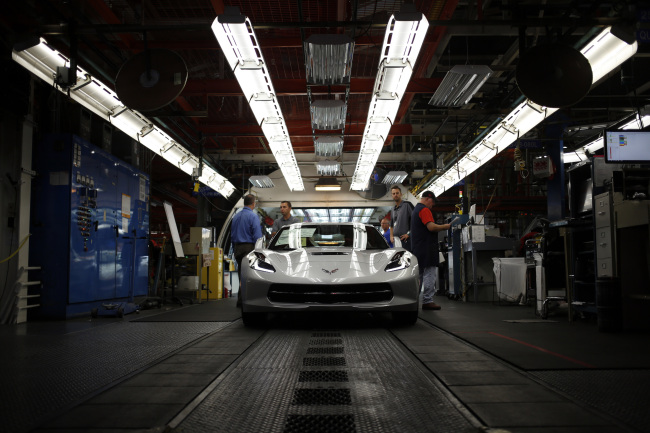 |
Workers inspect a 2014 Chevrolet Corvette Stingray at the General Motors Co. Bowling Green Assembly Plant in Bowling Green, Kentucky. (Bloomberg) |
WASHINGTON (AFP) ― The U.S. Treasury sold its last shares in General Motors on Monday, ending the dramatic rescue of the auto giant at the height of the financial crisis five years ago.
The Treasury took a loss of more that $10 billion on the $49.5 billion bailout, but said that saving the U.S. auto industry, the jobs of millions of auto workers and the pensions of many retirees was worth it.
The 2008 rescue, highly controversial at the time, “helped stabilize the auto industry, and prevent another Great Depression,” Treasury Secretary Jacob Lew said.
He said that President Barack Obama “understood that inaction could have cost the broader economy more than one million jobs, billions in lost personal savings, and significantly reduced economic production.
“Less than five years later,” Obama cheered in a separate statement, “each of the Big Three automakers is now strong enough to stand on its own.
“They’re profitable for the first time in nearly a decade. The industry has added more than 372,000 new jobs ― its strongest growth since the 1990s.”
In addition, “GM has now repaid every taxpayer dollar my administration committed to its rescue, plus billions invested by the previous administration,” he said.
In late 2008 the administration of then-president George W. Bush began the rescue of the industry which was then expanded into a comprehensive program by his successor Obama.
It was attached to the massive Troubled Asset Relief Program set up to rescue banks, amid worries that the collapse of the automobile industry would plunge the U.S. economy into deeper recession.
The government took financial control of both GM, the largest U.S. automaker, and Chrysler. Canadian authorities, worried about auto industry job losses on their side of the border, also took part in the rescues.
The number two producer, Ford, opted to stand on its own ― though analysts say that Ford benefited from the rescue of the two competitors, bolstering general confidence as well as saving the parts industry that all three share.
Treasury officials said the bailout of GM and Chrysler, which it exited earlier with the sale of most of its shares to Italian carmaker Fiat, would leave it with a net loss of about $15 billion.
In addition, the government also took over GM’s finance arm, now bank holding company Ally Financial, which the government still controls.
In a new study, the Center for Automotive Research said the government’s loss was paltry compared with the losses risked by letting GM and Chrysler go under.
Not including the potential impact on the parts sector, the study said the U.S. government “saved or avoided the loss of $105.3 billion in transfer payments and the loss of personal and social insurance tax collections ― or 768 percent of the net investment,” the study said.
“Additionally, 2.6 million jobs were saved in the U.S. economy in 2009 alone and $284.4 billion in personal income saved over 2009-2010.”
General Motors chairman and chief executive Dan Akerson expressed gratitude Monday for the government support.
“The U.S. Treasury’s ownership exit closes just one chapter in GM’s ongoing turnaround story. We will always be grateful for the second chance extended to us and we are doing our best to make the most of it,” he said in a statement.








